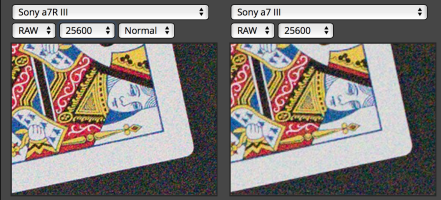you mean it the tests where they normalize the image to 8MP.
Choose whatever
image dimensions you like. The results will be the same.
from 3200 ISO, you start to see more noise from the A7R III and it becomes more evident from 6400 ISO upwards.
Not at the same view size. Here they are at 25,600, RAW, same view size:

The noise is sharper (vs. A7 III) but so is the whole image. And there's not more of it. Whether you print as is for maximum sharpness or apply some NR, the A7r III image will come out on top.
To be clear: all currently shipping FF bodies are excellent at high ISO. There's not even 1 stop difference between the best and the worst. But if we nitpick we find that it's not the lower resolution bodies that come out on top.
again i am not saying pixel size makes a huge difference today.
but imo there should be one (difference) just from a statistical/physical point of view (well capacity, noise , SNR ratio etc.)
Obsessing over "pixel quality" is missing the forest for the trees. If you have gapless micro-lenses the total image noise will be the same. Smaller pixels just means a higher sampling frequency resulting in higher resolution and ooc sharpness. The character of the noise is different because it is 'sharper' as well. That may annoy some people, but you have more room for NR in that case.
Well capacity is a real thing and should in theory mean that larger pixel sensors have higher DR. But for some reason it hasn't since at least 2012 (D800 release). For whatever reason, architecture has trumped this. Even with Canon's older, off-chip ADC architecture the highest DR sensor was also the highest pixel density sensor.
At this time you're not losing anything for sampling at a higher frequency (smaller pixels). I'm not saying this will always be true. Perhaps past a certain size noise scales at a rate which would make this untrue. But today? We're just not seeing a loss for having more MP.
Also: Did you actually read Clark's article? All the way to the end?
When choosing between cameras with the same sized sensor but differing pixel counts, times have changed. A decade ago, I would have chosen the camera with larger pixels (and fewer total pixels) to get better high ISO and low light performance. Today I would choose the higher megapixel (thus smaller pixels). Modern cameras with high megapixel count, low read noise and low electronics noise allow one to trade resolution and noise. If one wants reasonable dynamic range in a high megapixel camera, the pixels must still be large enough to hold enough photoelectrons to give the dynamic range. Currently (circa 2016), that is not much smaller than 4 micron pixel spacing. For example, the 50 megapixel Canon 5DS(r) fits this criteria, and Nikon's D800 and D810 are in the same league.

